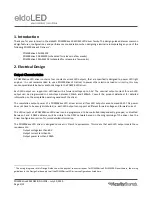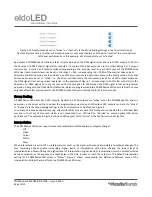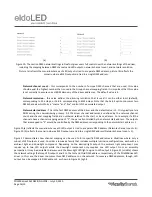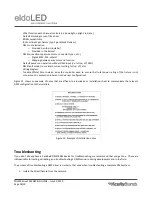
POWERdrive 50W DESIGN GUIDE
–
July 30, 2020
Page 15/19
may need to be specified. The preferred behavior in the example above is that the maximum output current per LED
output is gracefully scaled back as more LEDs are turned on, while still maintaining the proper drive current ratio between
the 4 LED outputs to ensure color accuracy. Power Scaling is designed to support this. With Power Scaling enabled, the
total power delivered by the POWERdrive LED driver can remain constant, regardless of how many LED outputs are on.
Furthermore, Power Scaling allows the POWERdrive LED driver to operate close to its maximum output power rating,
regardless of the number of LED outputs that are on.
Power Scaling is disabled when set to 0 (default), i.e. the POWERdrive LED driver will deliver on the incoming DMX
setpoints for all LED outputs, regardless whether the requested DMX setpoints result in an overpower situation. To enable
Power Scaling, enter an integer value in the range 1
–
255 in FluxTool. Use this formula to calculate the appropriate value
for Power Scaling:
Power Scaling = 255 x P
max LED driver
/ P
max LED load
(rounded to the nearest integer)
where
P
max LED driver
is the maximum output power of the POWERdrive LED driver
P
max LED load
is the worst-case LED load that the LED driver may experience
Going back to the example above, P
max LED driver
= 50W. Now, let
’s
further assume that the output current for each LED
output is programmed to 1000mA. The worst-case LED load that the LED driver could experience occurs when all 4 LED
outputs are on at full brightness, i.e. P
max LED load
= 4 x 1000mA x 50V = 200W. The appropriate Power Scaling value in this
example, per the formula above, is then 64. Whenever the sum of DMX setpoints for all four LED outputs exceeds the
Power Scaling value x N, where N is the total number of LED outputs that are active (see Figure 8), Power Scaling reduces
the output current to all LED outputs while maintaining the proper ratio between LED outputs. Continuing the example
above, if the DMX setpoint for LED output 1 is 255 while the DMX setpoint for the other three LED outputs is 0, Power
Scaling is not applied (255 + 0 + 0 + 0 < 64 x 4), i.e. the output current to LED output 1 is 1000mA. Now consider the
scenario where the DMX setpoint for LED output 2 is changed from 0 to 255. Since the sum of incoming DMX setpoints
now exceeds the maximum allowable sum (255 + 255 + 0 + 0 > 64 x 4), Power Scaling kicks in and reduces the current to
both LED outputs proportionally, i.e. LED outputs 1 and 2 now deliver each only 500mA. In both scenarios, the total power
delivered by the POWERdrive LED driver remains at 50W.
Note that the Power Scaling formula above is only suitable if all LED outputs have similar LED loads. For asymmetric load
conditions, please contact your eldoLED Sales representative for further assistance in calculating the appropriate Power
Scaling value.
DMX network settings
A POWERdrive LED driver has 4 LED outputs which, by default, are tied to separate, sequential DMX addresses, allowing
each LED output to be controlled independently. However, in some applications it may be desirable to tie multiple LED
outputs to the same DMX address, allowing multiple LED outputs to react in unison to a dimming command. The mapping
between DMX addresses and LED outputs can be fully configured in the section DMX network settings in FluxTool, see also
Figure 10:
Group x channel mapping with x in {1, 2, 3 4}
–
specifies to which DMX address (
“
channel
”
) each LED output
(
“
group
”
) is tied. 1 corresponds to the network start address specified. Valid values are between 1 and Network
channel count.





































